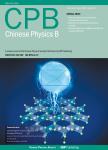Investigations of the dielectronic recombination of phosphorus-like tin at CSRm
Investigations of the dielectronic recombination of phosphorus-like tin at CSRm作者机构:Hefei National Laboratory for Physical Sciences at Microscale and Department of Modern Physics University of Science and Technology of China Hefei 230026 China Synergetic Innovation Center of Quantum Information and Quantum Physics University of Science and Technology of China Hefei 230026 China Institute of Modern Physics Chinese Academy of Sciences Lanzhou 730000 China School of Physical Sciences University of the Chinese Academy of Sciences Beijing 100049 China Shanghai EBIT Laboratory Institute of Modern Physics and Key Laboratory of Nuclear Physics and Ion-beam Application (MOE) Fudan University Shanghai 200433 China National Synchrotron Radiation Laboratory University of Science and Technology of China Hefei 230026 China 7 The Key Laboratory of Computational Physics Institute of Applied Physics and Computational Mathematics Beijing 100088 China 8Institute for Fundamental Physics Tianshui Normal University Tianshui 741000 China 9 Key Laboratory of Atomic and Molecular Physics and Functional Materials of Gansu Province College of Physics and Electronic Engineering Northwest Normal University Lanzhou 730070 China
出 版 物:《Chinese Physics B》 (中国物理B(英文版))
年 卷 期:2018年第27卷第6期
页 面:268-273页
核心收录:
基 金:supported by the National Key Research and Development Program of China(Grant No.2017YFA0402300) the Chinese Academy of Sciences the National Natural Science Foundation of China(Grant Nos.U1732133,11320101003,11611530684,and 11604003)
主 题:dielectronic recombination trielectronic recombination storage ring electron cooling
摘 要:The electron–ion recombination for phosphorus-like^(112) Sn^(35+)has been measured at the main cooler storage ring of the Heavy Ion Research Facility in Lanzhou, China, employing an electron–ion merged-beams technique. The absolute total recombination rate coefficients for electron–ion collision energies from 0 e V–14 e V are presented. Theoretical calculations of recombination rate coefficients were performed using the Flexible Atomic Code to compare with the experimental results. The contributions of dielectronic recombination and trielectronic recombination on the experimental rate coefficients have been identified with the help of the theoretical calculation. The present results show that the trielectronic recombination has a substantial contribution to the measured electron–ion recombination spectrum of^(112)Sn^(35+). Although a reasonable agreement is found between the experimental and theoretical results the precise calculation of the electron–ion recombination rate coefficients for M-shell ions is still challengeable for the current theory.



